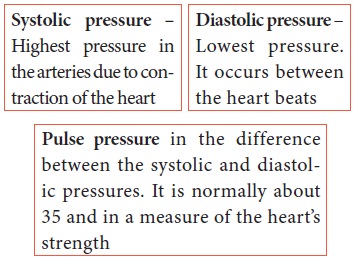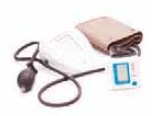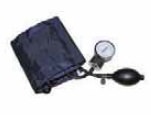Nursing - Blood Pressure - Physical Examination | 11th Nursing : Chapter 5 : Nursing - Health Assessment and Physical Examination
Chapter: 11th Nursing : Chapter 5 : Nursing - Health Assessment and Physical Examination
Blood Pressure - Physical Examination
Blood Pressure
Blood pressure is the force or
pressure of blood against the walls of blood vessels as it flows through them.
It depends on the following factors:
1.
Force of the heart beat
2.
Elasticity of the blood vessel wall
3.
Volume of blood in circulation
4.
Dilatation
on concentration of the small arteries and capillaries

Variation in Blood pressure:
__________Fear
____________ Worry
_______________ Emotions
_____________________ Exercise
Hyper tension – high blood
pressure 140/90 mmHg
Hypo tension – low blood pressure
90/60 mmHg
Types of Blood pressure Monitoring Equipment
1.
Sphygmomanometer:
It includes a pressure manometer, unify cuff inflatable rubber bladder and a
pressure bulb with a release valve that inflates the bladder.

2.
Electronic
Blood pressure device: Many different types of electronic BP machines are
available to determine BP automatically. They relay on an electronic sensor to
detect the vibrations caused by the rush of blood through an artery.

3.
Self-measurement
of blood pressure: Electronic monitoring device allows individuals to measure
their own BPs in their home with the rush of button.

4.
Dial
type of BP apparatus: It is lighter and useful for home visits. There is no
mercury or glass. But this type may be not as accurate as the sphygmomanometer.

A stethoscope should be used with
the BP apparatus in order to listen to the sounds of the brachial pulse and
determine the BP reading.
Method of taking the Blood Pressure
1.
Explain the procedure to the patient and have him seated by a
table or lying with the arm supported and relaxed.
2.
Place
the centre of the cuff of the BP apparatus over the brachial artery and wrap it
smoothly and firmly around the patient’s arm 5cm just above elbow. Junk the end
neatly.
3.
Find the brachial pulse with the fingers and place the
stethoscope over it.
4.
Close the sinew valve and inflate the cuff until the pulse
disappears and above that about 20 mm mercury
5.
Open the valve slowly and listen for the first sound while
watching the manometer reading. The first sound given the systolic reading. As
air escapes, the sounds become louder and cleaner.
6.
Continue to let air out slowly. As you listen the sounds
suddenly become dull and at this point take the Diastolic reading.
7.
Allow all the air to escape and the mercury to all to zero
8.
Repeat the procedure, if there is any doubt about the reading
9.
Record the reading the systolic pressure in always written over
the Diastolic pressure eg. 120/80 mmHg
10.
Remove the cuff from the patient’s arm, roll and replace in the
box.
Related Topics